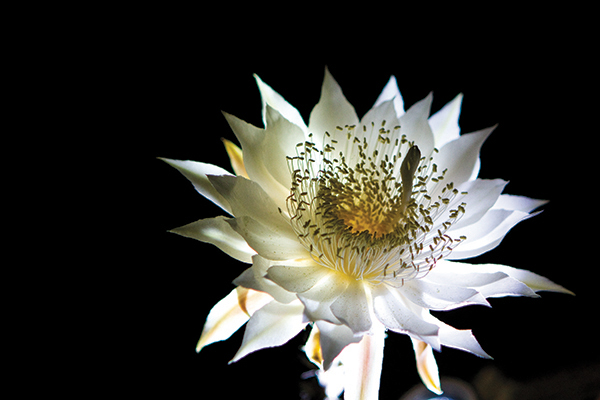Bloom Night

Peniocereus greggii. Photo by David Olsen
The email hits your inbox early in the afternoon. Your heartbeat elevates. Nobody died, nobody was born. Nobody you know won Powerball. In fact, this email doesn’t even concern a person. It’s all about the most nondescript, inconspicuous, seemingly lifeless branches you’ll find – or likely not ever notice – on the desert floor.
It’s that time of year again for the 22nd Annual Bloom Night at Tohono Chul Park, 7366 N. Paseo Del Norte, just north of Ina Road. Unlike any other Tucson event, nobody has a clue when Bloom Night will fall, other than somewhere between mid-May and mid-July.
People instantly cancel whatever plans they have for that evening for a close-up encounter with a blooming peniocereus greggii. Those of you in the know realize we’re talking about the Night Blooming Cereus, fondly called the Queen of the Night.
Why all the hullabaloo? This flower blooms for a single night. Palm-sized white flowers start to unfurl at about 5pm. The flower is open in full bloom by 8pm for a single night. Then the flower dies as the sun rises the next morning. And it’s all over until next year. Or maybe it’s not.
For promotion’s sake, the Queen of the Night in the Sonoran Desert bloom together. The greater majority do bloom on a single night, but Tohono Chul has had years with two Bloom Nights—when half of the plants bloom on one night and the other half the following night or two months later.
“There’s no rhyme or reason,” Marcia Ring, Tohono Chul’s marketing director says, “They’re very unpredictable.”
For 364 days a year, the night blooming cereus look like dead sticks. They are nothing more than four-sided branches up to three-feet long but usually shorter. They grow in haphazard directions, usually more horizontally, close to the ground, often tangled with another plant.
They have no attractive quality whatsoever – except for that gorgeous white flower that gets Tucsonans to drop everything at a moment’s notice to have a look. Nobody does that for a rose. What is it about the Queen of the Night?
“A rose does not have the determination this plant has,” Ring says. “If you think about it, this ugly, nasty, little plant collects and saves its resources for a year so it can create a bloom that lasts for only one night.”
But that in no way means every Queen of the Night blooms. Tohono Chul has 350 night blooming cereus, the world’s largest collection. Last year, Bloom Night produced 89 flowers on 42 plants. Ultimately, 58 plants produced 146 flowers in 2012.
Out in the Sonoran Desert, the only place this plant grows, you usually don’t find more than one night blooming cereus per acre. Keep that in mind when you consider this: the plants seem to communicate with each other. The blooms from plant to plant mature at different rates. Then all of a sudden a faster growing plant will slow down so that all the Queen of the Nights can bloom the same night. On top of that, they are pollinated by the hawk moth, which is born that very night, collects pollen from one plant and delivers the pollen to another plant on another acre.
Ring is master of Tohono Chul’s Bloom Watch List, which has about 11,000 names on it. You can add your name to the Bloom Watch List at bloomwatch2013.org. The Bloom Watch starts with email updates every two weeks, then once a week and then daily when the buds near blooming size.
More often than not Ring sends out the Bloom Night announcement between noon and 3 pm just before the flowers start opening that evening. As many as 2,500 people have made the last minute drive to Tohono Chul for Bloom Night. Last year, the count was only 1,000 people, possibly because the announcement didn’t go out until 3:45 pm and it was a Saturday.
It’s a Tucson thing, no doubt. We all know there’s not much to do here in sweltering June or July. But the botanical garden in Phoenix sends a busload to Tohono Chul for Bloom Night and a dozen people typically make a mad dash from New Mexico.
“I had a girl, she was Dutch, and she planned an entire vacation around Bloom Night,” Ring said. “I called her and she was in Flagstaff that day.” The Dutch girl got to see the flower.
Tohono Chul opens at 6 pm for Bloom Night and closes at midnight to give the hawk moth some peace to get on with the pollinating chores. Admission is $5 for non-members and free for members. This will be the second year Tohono Chul will reopen at 5am for a member-only look at the end of the Queen of the Night’s life cycle.
“Bring a flashlight and a camera and wear sensible shoes,” Ring said. “We put up some luminarias but you are still tramping through a desert at night time.”
People do have bloom parties at their homes. You can buy potted Queen of the Night plants at Tohono Chul for $100 for a mature plant. Smaller plants go for $25 and $10 but you get no more than a stub for $10. The peniocereus greggii comes with no guarantees.
“If you plant one, it could be 10 years until you get a bloom of your own,” Ring said, “Or it may never bloom.”
Learn more at www.tohonochulpark.org
Category: Community, RECREATION, The Scoop




